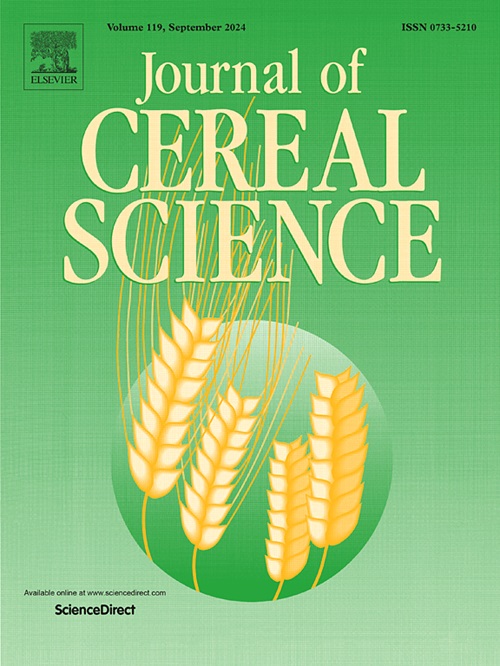Greater impact of pre-flowering high temperature stress on nutrient content in purple sweet waxy maize grains compared to post-flowering stress
IF 3.7
2区 农林科学
Q2 FOOD SCIENCE & TECHNOLOGY
引用次数: 0
Abstract
Purple sweet waxy maize is valued for its distinctive nutritional profile and flavor. High temperature stress, which can occur at any developmental stage, poses a significant threat to maize production. Understanding its effects on maize quality is essential for developing effective strategies to cope with climate change. This study investigated the effects of high temperature stress during pre-flowering (V12-T and VT-T) and post-flowering (VT+10-T) stages on the nutritional composition of purple sweet waxy maize grains in 2022 and 2023. Compared to natural temperature conditions (CK), high temperature stress increased the activity of flavonoid 3′-hydroxylase (F3′-H), thereby promoting anthocyanin synthesis, however, it significantly reduced grain weight and anthocyanin accumulation. Specifically, V12-T, VT-T, and VT+10-T treatments reduced the mean anthocyanin accumulation over two years by 22.45 %, 43.70 %, and 12.76 %, respectively, with the VT-T treatment resulting in the greatest decline. High temperature stress also disrupted sucrose and starch metabolism, inhibited starch synthesis in endosperm cells and reduced the two-year mean starch content by 24.06 %, 40.94 %, and 21.46 % for the V12-T, VT-T, and VT+10-T treatments, respectively. In addition, it decreased starch paste viscosity and thermal stability, and increased surface porosity and depression of starch granules, thereby compromising starch quality. High temperature stress decreased the contents of albumin, globulin, and gluten, while increasing prolamin content, which has lower nutritional value. Overall, high temperature stress significantly affected the accumulation and quality of key grain components, including anthocyanins, starch, and protein fractions, by disrupting multiple physiological and biochemical processes, particularly sucrose and starch metabolism. Notably, high temperature stress during the pre-flowering stage, especially at the VT stage, caused the most severe negative effects.

花前高温胁迫对紫色甜糯玉米籽粒养分含量的影响大于花后高温胁迫
紫甜糯玉米因其独特的营养成分和风味而受到重视。高温胁迫可以发生在玉米的任何发育阶段,对玉米生产构成重大威胁。了解其对玉米品质的影响对于制定应对气候变化的有效策略至关重要。研究了花前(V12-T和VT- t)和花后(VT+10-T)阶段高温胁迫对2022年和2023年紫色甜糯玉米籽粒营养成分的影响。与自然温度条件(CK)相比,高温胁迫提高了黄酮类3′-羟化酶(F3′-H)活性,促进了花青素合成,但显著降低了籽粒重和花青素积累。其中,V12-T、VT- t和VT+10-T处理2年平均花青素积累量分别降低22.45%、43.70%和12.76%,其中VT- t处理下降幅度最大。高温胁迫还破坏了胚乳细胞的蔗糖和淀粉代谢,抑制了淀粉合成,使V12-T、VT- t和VT+10-T处理的2年平均淀粉含量分别降低了24.06%、40.94%和21.46%。此外,它还降低了淀粉糊的粘度和热稳定性,增加了淀粉颗粒的表面孔隙率和凹陷,从而影响了淀粉的质量。高温胁迫降低了白蛋白、球蛋白和面筋含量,提高了蛋白含量,其营养价值较低。总体而言,高温胁迫通过扰乱多种生理生化过程,特别是蔗糖和淀粉代谢,显著影响了籽粒关键成分(包括花青素、淀粉和蛋白质组分)的积累和品质。其中花前期,特别是VT期的高温胁迫对植株的负面影响最为严重。
本文章由计算机程序翻译,如有差异,请以英文原文为准。
求助全文
约1分钟内获得全文
求助全文
来源期刊

Journal of Cereal Science
工程技术-食品科技
CiteScore
7.80
自引率
2.60%
发文量
163
审稿时长
38 days
期刊介绍:
The Journal of Cereal Science was established in 1983 to provide an International forum for the publication of original research papers of high standing covering all aspects of cereal science related to the functional and nutritional quality of cereal grains (true cereals - members of the Poaceae family and starchy pseudocereals - members of the Amaranthaceae, Chenopodiaceae and Polygonaceae families) and their products, in relation to the cereals used. The journal also publishes concise and critical review articles appraising the status and future directions of specific areas of cereal science and short communications that present news of important advances in research. The journal aims at topicality and at providing comprehensive coverage of progress in the field.
 求助内容:
求助内容: 应助结果提醒方式:
应助结果提醒方式:


